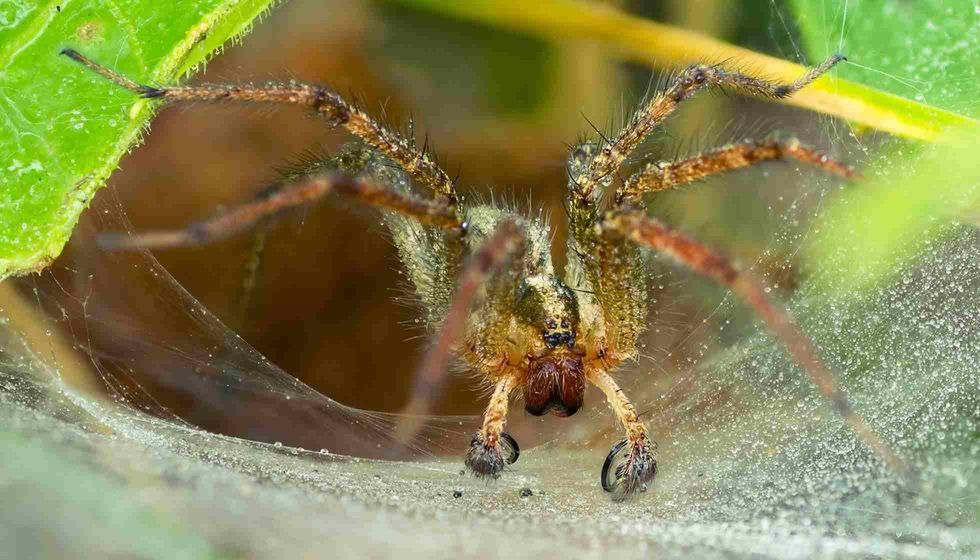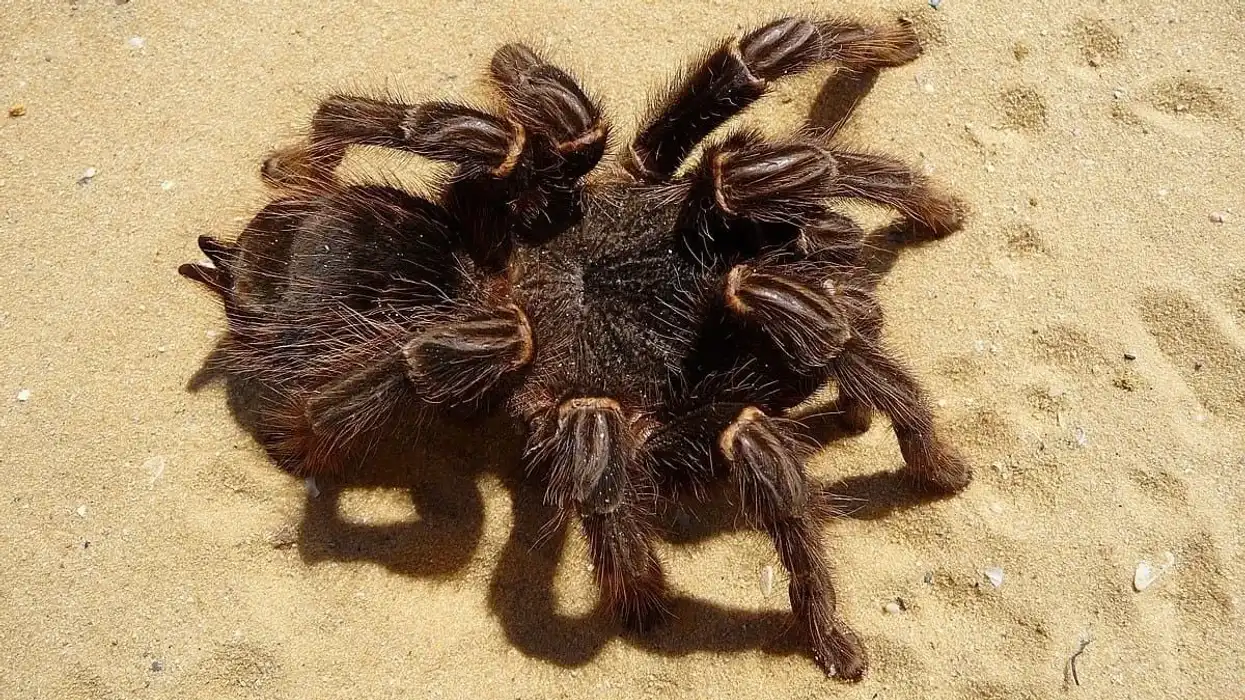The American grass spider, belonging to the funnel weaver genus of spiders, is a common sighting in North America and Canada. These spiders make webs in grasses and are often found among domestic habitats that are ripe with bugs and insects. Their web is unique in comparison to other spider species, as it isn't sticky.
Their webs are often in the shape of funnels and they use their tail like spinnerets to spin webs. They are often seen as pests and are docile and non-aggressive in nature as they are shy and don't seek contact with humans.
Their bites are venomous but not poisonous, so in case you get bit by a grass spider, it's safe to assume it will just sting for a while and will not turn lethal in nature.
If you liked these true facts about grass spiders, then you'll surely like these facts about garden spiders and huntsman spiders.
Grass Spider Interesting Facts
What type of animal is a grass spider?
Agelenopsis, or commonly known as the American grass spider or Funnel-web spider, is a spider belonging to the funnel weaver genus of spiders and is venomous, but not poisonous, as a grass spider bite can cause distress but is not fatal. They are small spiders and compared to other spiders, grass spider webs are not sticky.
They are small in nature and grow only a handful of millimeters in size. They are, however, extremely agile.
What class of animal does a grass spider belong to?
The grass spider belongs to the Arachnid class of animals and the funnel weaver genus. Arachnids include species containing spiders which make up the largest order, alongside scorpions, mites, ticks, and solifuges to name a few.
Arachnid adults can be distinguished by their eight legs, however, the pair of front legs in some species of arachnids serve the function of sensation, while in other species, extra pairs of legs are formed by different appendages that have grown large enough.
There are over 100,000 named arachnid species with the majority being terrestrial (land dwellers) while a few of them also inhabit freshwater and marine environment.
How many grass spiders are there in the world?
As these spiders belonging to the funnel weaver genus, they are found in abundance in North America, yet there is no exact population count for these small spider species.
Where does a grass spider live?
Grass spiders can be found in the wild as well as domestic habitats as a dirty environment may not attract grass spiders themselves, but food crumbs and other sticky residue left by drinks attract a pest like ants, which in turn, are food for these spiders causing a grass spider infestation.
Grass spiders feed mainly on small insects and a dirty environment is full of them, hence they can be found in most domestic habitats that are dirty or polluted.
What is a grass spider's habitat?
Grass spiders are so-called because they are found in tall grass that has a heavy cover with thick shrubs. Grass spiders are rarely seen indoors, except for a rare instance of the wandering male grass spider. Hobo spiders, belonging to the same family of spiders, can be found in households as they are regular invaders.
Who do grass spiders live with?
Grass spiders are solitary in nature just like most of the other spider species. They can, however, share their habitat with other grass spiders.
How long does a grass spider live?
Grass spiders have a life cycle that is between one and two years along and this cycle is completed with their mating ritual as it brings an end to both the male and female. The male grass spider will die shortly after the mating procedure is completed and after laying the eggs, the female dies shortly thereafter.
How do they reproduce?
Males will portray a series of movements to catch the female's attention and also might sway their abdomen as if doing belly dance, their movements release pheromones, and if the female is interested she will allow the male to mate with her.
Grass spiders portray boldness and aggression during the mating procedure. Their gonads are located in their abdomen and the genital opening is on the underside of the abdominal segment, the male transfers sperm to the female in a spermatophore.
Female grass spiders lay egg sacs in the late summer and during fall. This egg sac is yolky in nature and the eggs will hatch in the spring, giving birth to babies that look like the miniature version of the adults.
The female spider is the only one who provides food and care and for the babies as males of these species take no part in child-rearing.
What is their conservation status?
Grass spiders are found all over North America and parts of Canada in abundance and are often considered pests. But since they play an important role in the ecosystem by eliminating small insects by preying on them as a food source, they are often left alone unless there is a case of an infestation.
An accurate number of their population is hard to come by due to data deficiency but it can be assumed that they are thriving and have a high population.
Grass Spider Fun Facts
What do grass spiders look like?

Grass spiders are often identified by their webs that are shaped like a funnel, hence the name funnel weavers. They have a body that is narrow in nature and have long legs. With a large spinneret at the end of their abdomen which resembles a short tail.
Depending on the species they belong to, grass spider eyes can range from six eyes to eight eyes, which are often arranged in parallel rows. The brown grass spider is the most common variation in color that can be found.
How cute are they?
They are more tolerable than cute. The common grass spider isn't good looking and will often get a reaction from humans that shows disgust. They are, however, helpful to us as they prey on insects that can be found around us.
How do they communicate?
The grass spider, like all other spider species, communicates using vibrations which are also known as seismic communication. They communicate during courting or mating procedures, when warning rivals or predators, or when they attempt to catch prey by mimicking the vibrations of insects caught in their webs.
How big is a grass spider?
The size of a grass spider differs among males and females as females are slightly larger than males.
How fast can a grass spider run?
Although accurate data on their speed cannot be found, these spiders are known for their high running speed. When they are in danger or sense predators around they start running rapidly.
How much does a grass spider weigh?
Due to a data deficiency, an accurate weight cannot be specified for these funnel-web spiders. A grass spider will grow from 0.3-0.7 in (9-20 mm) in length.
What are their male and female names of the species?
No specific name has been assigned to either gender of the species.
What would you call a baby grass spider?
A baby grass spider is called a spiderling. They are born from eggs. A female grass spider egg sac is yolky in nature.
Spiderlings are the exact replica of their adult parents but in miniature form!
What do they eat?
The funnel web grass spider preys on insects and bugs that are smaller than it, and in turn, they keep control of the insect infestation around you that is caused by leaving traces of food crumbs. They use their venom to paralyze the insects that are caught in their webs.
Are they poisonous?
The grass spider is not poisonous, however, it is venomous. When agitated or harassed they will bite humans or other animals. Grass spider bites symptoms are itching and rashes on your skin but they are not lethal.
Would they make a good pet?
Grass spiders can be good pets as they are low maintenance and need to be fed once a week! In captivity, they are often found building extensive webs in their cages and are a joy to watch as they go about their daily routine!
Did you know...
The Agelenidae family is divided into 82 genera and has 1307 species of spiders, with the grass spider belonging to the funnel weaver genus.
These spiders seldom bite and will do so only when they are agitated. Their fangs aren't big enough to penetrate human skin.
If you find a grass spider in your house, chances are it's a male spider that has made its way inside as males are adventurous.
Funnel-web grass spiders are attracted by a large population of insects and other bugs.
The black grass spider is the second common spider after the brown one.
The webs of the funnel-web grass spiders are nonsticky.
If you see one or two spiders around you, then it's suggested that you leave them alone as they as nature's pest control.
If you are seeing an increase in the grass spider population in and around your house, chances are it's the beginning of an infestation. To get rid of these spiders you will need to get rid of brush piles, trim your garden, and remove webs.
What's the difference between a wolf spider and a grass spider?
Grass spiders are one of approximately 1,200 species found within the Agelenidae family.
They are often confused with wolf spiders as they have a similar color pattern but can be differentiated easily as wolf spiders do not spin webs, instead, they are often found living in burrows, whereas, grass spiders spin webs and capture prey and live in their web.
In a grass spider vs wolf spider bite contest, a wolf spider will win as they are the most likely to bite and the wound will hurt.
What is special about a grass spider's web?
These spiders have funnel-sized webs that are well built but are not sticky, and it makes it difficult for the prey to escape. Once the prey has been trapped, the grass spider will bite it and venom is injected into it. They also use the web as a hiding spot for themselves in case they sense a predator.
Here at Kidadl, we have carefully created lots of interesting family-friendly animal facts for everyone to discover! Learn more about some other arthropods including the brown recluse spider and the hobo spider.
You can even occupy yourself at home by drawing one of our Grass spider coloring pages.










